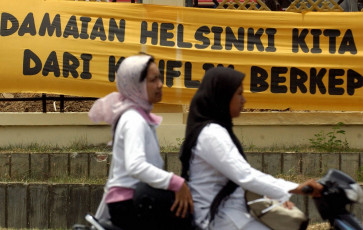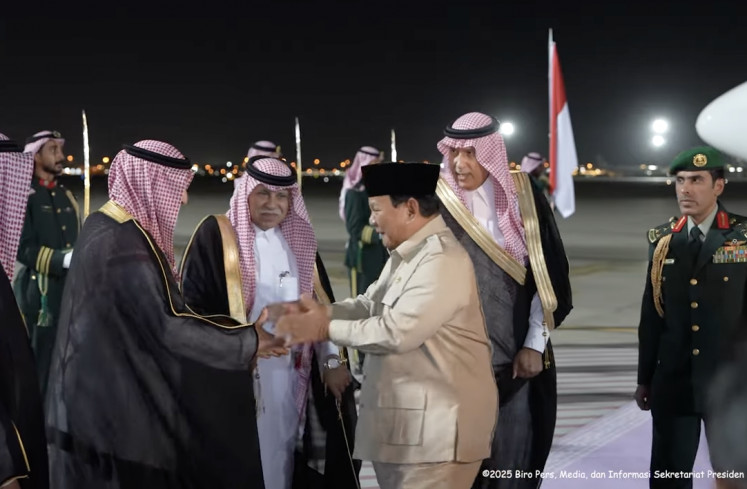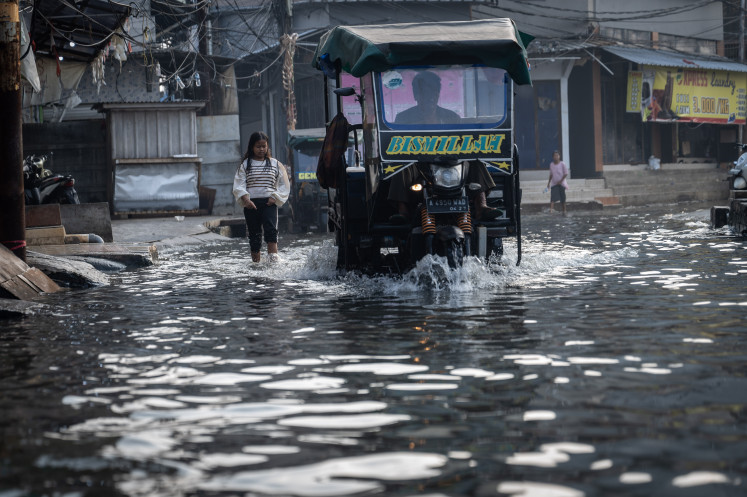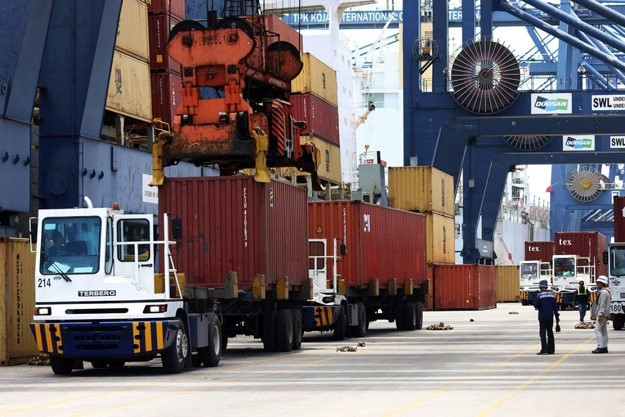Popular Reads
Top Results
Can't find what you're looking for?
View all search resultsPopular Reads
Top Results
Can't find what you're looking for?
View all search resultsClothing business turns jobless women into entrepreneurs
Delicate work: Yeti Cahyati (left) talks to one of her employees (center) in Lembang, Bandung, West Java, on Oct
Change text size
Gift Premium Articles
to Anyone

D
elicate work: Yeti Cahyati (left) talks to one of her employees (center) in Lembang, Bandung, West Java, on Oct. 9. Her underwear business started in 2012 after she received loans from lender BTPN Syariah.(JP/Eisya A. Eloksari)
Yeti Cahyati never thought that her underwear business would be able to support her family of seven. Under the brand BHK, the 53-year-old woman earns Rp 10 million (US$707) weekly.
The mother of five has been in the garment business for seven years since she became a Bank Tabungan Pensiunan Nasional (BTPN) Syariah client. She received Rp 1.5 million in 2012 as an initial loan to kick-start her business, as part of the bank’s underprivileged women empowerment program, Future Package (PMD) program.
“I started the business by selling pants but turns out that I made my fortune by selling underwear,” Yeti said on Oct.10.
She said her employees could produce up to 750 pieces of underwear daily, which she sold starting at Rp 50,000 per dozen. She added that her son, Iqbal Kurniawan, 23, helped her with online sales but she still went to the market daily to sell the undergarments herself.
Another loan recipient is 44-year-old IIs Komala, who owns a modest wear clothing line called A-Mulya. She was able to put her eldest daughter through college, while her second-oldest was about to enter flight school.
She received an initial Rp 2 million loan in 2012, and now is eligible to apply for Rp 75 million loan.
“I was once rejected by a venture capital company because they did not trust that I would be able to pay back the loan,” she said, adding that she and her husband used to be jobless and did not have an income before joining the PMD program.
Iis employs more than 20 people from around her village in Kutawaringin regency, Bandung, West Java. She said that she could earn up to Rp 200 million per month by selling tunics and dresses starting from Rp 60,000.
“I’ve been able to put my children through school, fix my house and support my family,” she said, adding that her husband and two sons now helped her run the business.
BTPN Syariah compliance director Arief Ismail said Yeti and Iis were among the bank’s 3.6 million underprivileged clients, all of whom were women, in 23 provinces.
“We focus on women because if they are financially empowered, then the money will eventually go back to the family’s welfare such as for education, home renovations and savings,” he said on Oct. 11, adding that women who had supportive husbands and children were also more likely to succeed.
According to the bank’s report, it has booked total assets of Rp 12 trillion, with total financing of Rp 7.3 trillion channeled to productive underprivileged customers as of December 2018. While the number of nonperforming financing (NPF) was only 1.39 percent in the same period.
The report also showed that since 2010, more than 5 million customers received financing facilities with accumulated financing disbursement of Rp. 40.2 trillion.
Arief said the program was inspired by M. Yunus’ Grameen Bank in Bangladesh, a bank that relies on a burden-sharing system in which the burden to return a loan is shared among a group of people.
Meanwhile, BTPN Syariah communication head Ainul Yaqin said a sense of community among the women had seen them helping each other pay loans.
“Our clients could be considered very unbankable as they were jobless and we tapped into a demography where not a lot of banking or financial services would cater to their needs,” he told the press.
As of September 2018, Statistics Indonesia (BPS) data showed that the poverty rate stood at 9.66 percent, around 25 million people of the population who lived below the poverty line. It said that the number was the lowest ever recorded as the poverty rate was 11.3 percent in 2014 and 10.12 percent in 2017.
However, a recent Asian Development Bank report said that while the poverty rate had declined, nearly 40 percent of the population remained close to the national poverty line and was considered vulnerable to falling back into poverty, especially when they became ill or fell victim to natural disasters.
As the country pushes for more financial inclusion, the Financial Services Authority (OJK) has launched a branchless banking program in 2015, which provides digital financial services and the digitization of social assistance. The program has contributed to an increase in the nation’s financial inclusion rate from 36 percent in 2014 to 49 percent in 2017.
ADB data also showed that access to formal bank accounts for the poorest 40 percent of the population had increased to 37 percent in 2017, from 22 percent in 2014. Meanwhile, gender inclusion in financial access has also increased with 51 percent of Indonesian women having access in 2017 compared to only 38 percent in 2014.
Among the nation’s unbanked adults, over one-third of them considered distance as a key reason for not having a bank account. Nearly 70 percent of that population, however, owned mobile phones, which showed a significant opportunity for the use of app-based financial technology to tackle geographical barriers and increase financial inclusion.









